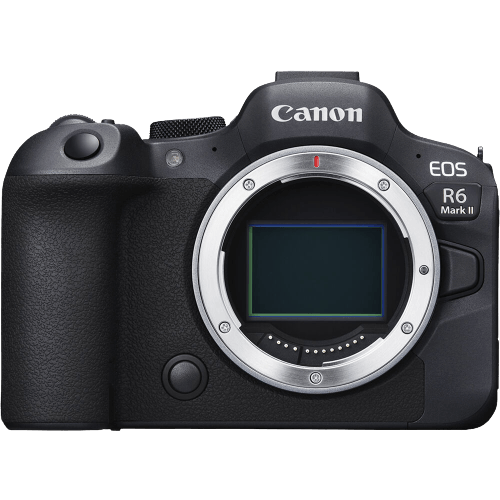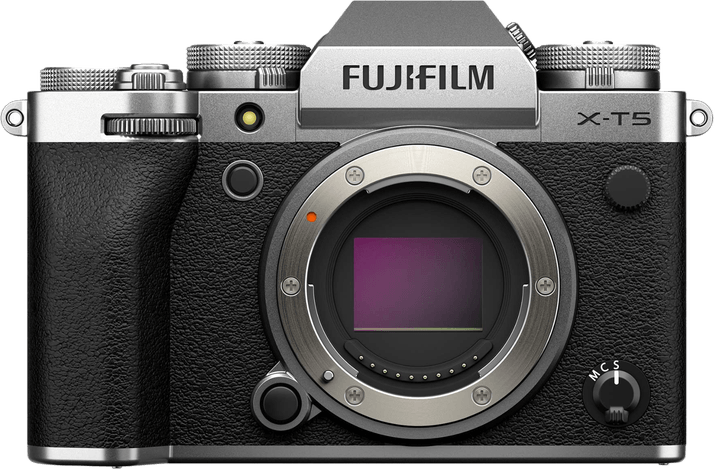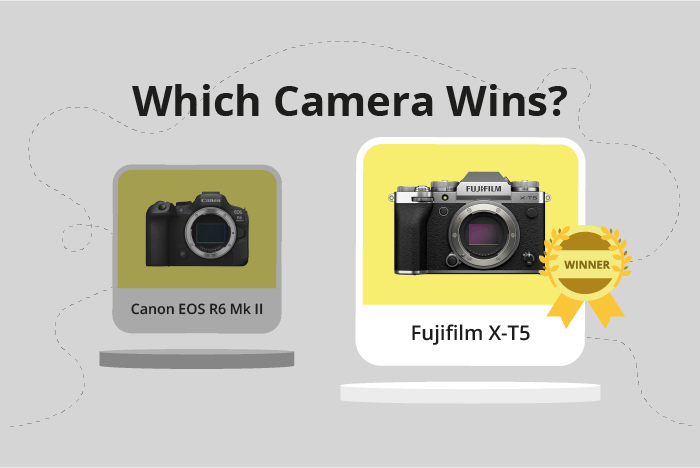Canon EOS R6 Mark II vs Fujifilm X-T5 Comparison
Canon EOS R6 Mark II

Fujifilm X-T5

The Fujifilm X-T5 outperforms the Canon EOS R6 Mark II with a score of 81/100 compared to 78/100. Both cameras are mirrorless, announced on 02/11/2022, and released in 2022. They share similarities in their general specifications; however, there are noticeable differences that set them apart.
The Fujifilm X-T5 is better in terms of price, costing $1699, and is lighter at 557g. Additionally, its compact design measures 130 x 91 x 64mm, making it easier to carry around. On the other hand, the Canon EOS R6 Mark II has a higher launch price of $2499 and weighs slightly more at 588g. Its dimensions are 138.4 x 98.4 x 88.4mm, making it bulkier than the X-T5.
Despite the higher price and weight, the Canon EOS R6 Mark II might offer advantages in other areas, such as optics or performance. However, considering the general specifications, the Fujifilm X-T5 is the more affordable and portable option.
Canon EOS R6 Mark II vs Fujifilm X-T5 Overview and Optics
The Canon EOS R6 Mark II wins the optics comparison with a score of 83/100, while the Fujifilm X-T5 scores 81/100. Both cameras share some common specifications, including a CMOS sensor, image stabilization, and a similar shooting speed, with the Canon at 40 and the Fujifilm at 15.
The Canon EOS R6 Mark II takes the lead with its full-frame sensor size, superior Digic X processor, and a DXOMARK score of 91 for its sensor. The full-frame sensor allows for better image quality and low-light performance compared to the Fujifilm X-T5’s APS-C sensor. Additionally, the Canon RF lens mount provides access to a wide range of high-quality lenses.
On the other hand, the Fujifilm X-T5 boasts a higher megapixel count of 40, compared to the Canon’s 24 megapixels. This advantage allows for more detailed images and better cropping flexibility. However, it is important to note that DXOMARK does not score Fujifilm cameras, so a direct comparison of sensor quality is not possible.
Though the Canon EOS R6 Mark II outperforms the Fujifilm X-T5 in terms of sensor size and processor, the Fujifilm X-T5 still has its merits with a higher megapixel count. Ultimately, the Canon EOS R6 Mark II’s full-frame sensor and superior processor make it the better choice for those prioritizing image quality and low-light performance. However, the Fujifilm X-T5 remains a strong contender for photographers seeking higher resolution images and the unique Fujifilm X lens lineup.
Canon EOS R6 Mark II vs Fujifilm X-T5 Video Performance
The Fujifilm X-T5 outperforms the Canon EOS R6 Mark II in video capabilities with a score of 87/100 compared to Canon’s 83/100. Both cameras share common features such as a maximum video frame rate of 60fps and built-in time-lapse functionality.
The Fujifilm X-T5’s superiority lies in its higher maximum video resolution and dimensions. With 6K resolution and dimensions of 6240×4160, it offers greater detail and clarity for videographers. This advantage allows the X-T5 to capture more stunning visuals and provide better overall video quality.
On the other hand, the Canon EOS R6 Mark II still delivers impressive video performance with its 4K resolution and dimensions of 3840×2160. Although it falls short of the X-T5’s 6K capabilities, the R6 Mark II remains a strong contender in the market for those seeking high-quality video capture.
In comparing these two cameras, the Fujifilm X-T5 clearly excels in video performance due to its higher resolution and dimensions. This makes it an ideal choice for videographers seeking the best possible video quality. Conversely, the Canon EOS R6 Mark II, while not matching the X-T5’s capabilities, remains a reliable option for those who prioritize video performance but do not require the highest resolution available.
Ultimately, the choice between these two cameras depends on the individual’s preferences and requirements. The Fujifilm X-T5 is the superior choice for video capabilities, but the Canon EOS R6 Mark II still has much to offer in terms of video performance.
Canon EOS R6 Mark II vs Fujifilm X-T5 Features and Benefits
The Fujifilm X-T5 outperforms the Canon EOS R6 Mark II in terms of features, scoring 85/100 compared to the Canon’s 72/100. Both cameras share several specifications, including a 3-inch screen, touchscreen capabilities, flip screen, WIFI, and Bluetooth connectivity.
The Fujifilm X-T5’s edge over the Canon EOS R6 Mark II is primarily due to its higher screen resolution of 1,840,000 dots, compared to the Canon’s 1,620,000 dots. This difference provides the X-T5 with a clearer and more detailed display, enhancing the user experience while composing shots and reviewing images.
In contrast, the Canon EOS R6 Mark II has the advantage of built-in GPS functionality, which the Fujifilm X-T5 lacks. This feature allows users to geotag their photos, making it easier to organize and locate images based on their shooting locations.
Despite the higher overall feature score of the Fujifilm X-T5, the Canon EOS R6 Mark II’s GPS capability may be more valuable for certain users, depending on their specific needs and preferences. However, the X-T5’s superior screen resolution remains a notable advantage, offering improved image display and overall usability.
To conclude, the Fujifilm X-T5 is the winner in terms of features, mainly due to its higher screen resolution. Nonetheless, the Canon EOS R6 Mark II offers the added benefit of GPS functionality. Potential buyers should weigh the importance of these features in relation to their individual requirements before making a decision.
Canon EOS R6 Mark II vs Fujifilm X-T5 Storage and Battery
The Fujifilm X-T5 outperforms the Canon EOS R6 Mark II in storage and battery, scoring 76/100 compared to the Canon’s 68/100. Both cameras have two memory card slots and support USB charging. They also accept SD, SDHC, and SDXC memory cards; however, the Canon is UHS-II compatible while the Fujifilm is UHS-I compatible.
The Fujifilm X-T5 offers a longer battery life of 580 shots, while the Canon EOS R6 Mark II provides 360 shots. This difference makes the Fujifilm X-T5 more suitable for extended shooting sessions. The Canon’s advantage lies in its UHS-II compatibility, allowing for faster data transfer rates, which is beneficial for burst photography and video recording.
Despite the Canon’s faster memory card compatibility, the Fujifilm X-T5’s longer battery life makes it the better choice for storage and battery performance. The Canon EOS R6 Mark II still offers respectable performance in this category, but the Fujifilm X-T5 proves to be the superior option.
Alternatives to the Canon EOS R6 Mark II and Fujifilm X-T5
Are you still undecided about which camera is right for you? Have a look at these popular comparisons that feature the Canon EOS R6 Mark II or the Fujifilm X-T5:

